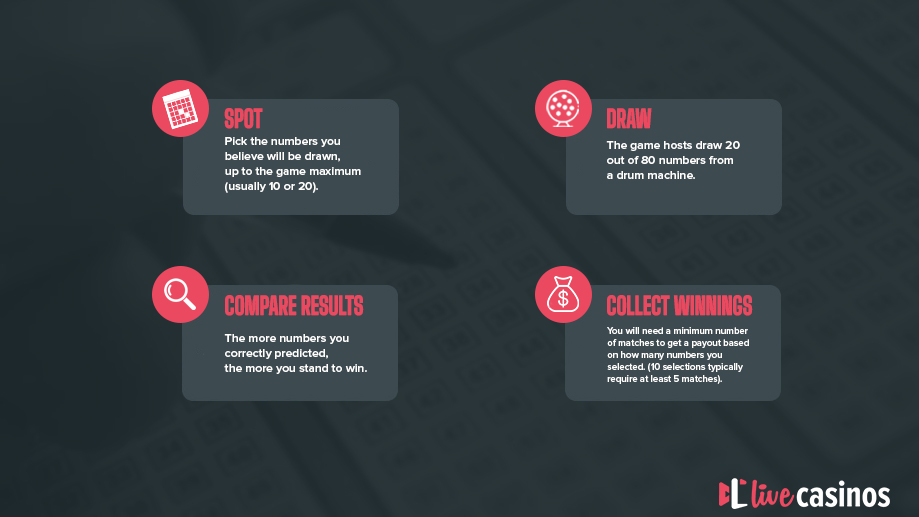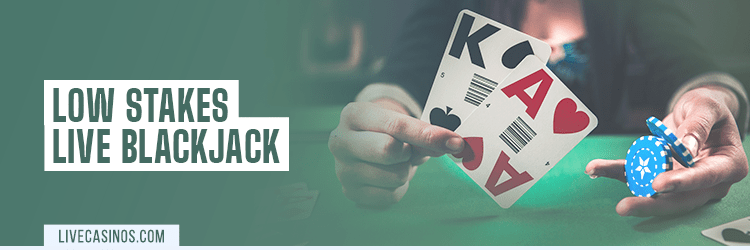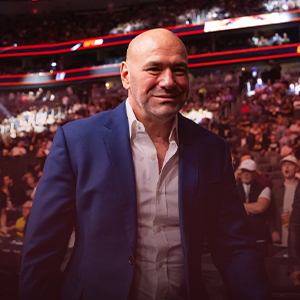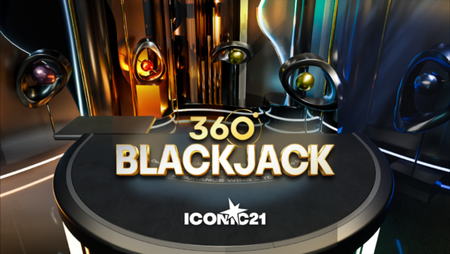Keno is a lottery-like gambling game that is increasingly popular in modern casinos, especially online. According to various sources, it dates back at least 2,000 years to ancient China, which makes it one of the oldest forms of gambling still practised today.
Compared to many other games of this style, Keno is noted for its fast pace and quick turnaround. Rounds don’t last nearly as long as in bingo, for example, which is why the game’s rules fit so well into the live dealer casino format.
Typically, a game of keno consists of a ball-drawing machine that contains 80 balls with numbers ranging from 1-80. Every player also has a card or ticket with 80 numbers, corresponding to the balls in the machine.
In every round, 20 balls are drawn from this machine. As a player, your job is to mark or circle up to 10 numbers on your card before the round starts. In online versions of the game, you usually mark your selected numbers simply by clicking or tapping on your virtual card.
The goal of keno is to accurately predict which numbers will be drawn in the upcoming round. The more numbers you get right, the more you’ll win. You usually need at least 5 matching numbers to win a payout, but the rewards increase exponentially for every correct prediction beyond 5.
That said, the concept of Keno is fairly versatile and can be easily changed or modified. As such, there are quite a few variations of the game out there. These variations typically affect how many numbers are drawn, how many numbers players can select, or the payout structure of the game overall.
The version of Keno we’ll be talking about in this guide is often called “spot Keno”. It’s arguably the most widespread version of the game. Spot Keno allows players to pick up to 10 numbers per card and draws exactly 20 out of 80 balls per round. However, since other variants don’t really change how the game works at its most basic level, this guide can be applied to pretty much any type of Keno – or even other lottery-like games.

Overview of Odds in Keno
The odds of winning Keno depend on many factors, such as how many numbers you’ve picked out and how many you need to get a worthwhile payout. However, the actual statistics are a bit more complicated than you would expect from such a simple game.
Here’s a simple breakdown of how odds in keno work and how you should understand its statistics.
- At the beginning of a round, every number has a 20/80 chance of being drawn because 20 numbers are picked out of a total of 80. This translates to 1 in 4, or 25%.
- While this seems low, you should keep in mind that this chance applies to every individual number you’ve selected. In other words, you get 20 opportunities to win a 1-in-4 odds, which isn’t very difficult to do. That’s why most player cards are expected to get at least one or two numbers right.
- However, due to how statistics work, correctly predicting a sequence of numbers is much lower. The odds of correctly guessing 2 numbers are around 1 in 8, which drops down to 1 in 12 for the third number, and so on.
- The probability of hitting 5 numbers and getting a prize is often calculated at 1 in 20. However, payouts are typically quite low for only 5 matching numbers.
- The probability of better wins decreases exponentially beyond 5. For instance, your chances of predicting a 6-number sequence are around 1 in 88, while the odds of getting 7 numbers right are 1 in 621.
- The chances of predicting all 10 numbers are almost negligibly small at around 1 in 8,911,712.
To sum up, the odds of drawing any individual number in Keno are 1 in 4. However, the whole “trick” with the game is that the chances of predicting an entire sequence are much, much lower – especially since you’ll need at least 5 to win.
You can refer to the table below for more info on how likely you are to win Keno. Note that the table assumes you make 10 selections in a game of Keno that draws 20 numbers. Picking the most numbers you can is typically the best strategy, which is something we’ll examine later.
Number Strategies in Keno
Since Keno is a game about picking numbers, many players naturally wonder whether some numbers are better than others.
This has led to many so-called Keno number strategies – pre-made selections and patterns that supposedly have a higher chance to win than other numbers.
If you’re wondering whether number strategies in Keno actually work, we have some good news and some bad news.
The good news is that there are certain benefits to sticking to certain numbers when filling out your card. Some data even supports a few of these claims, though the underlying maths are suspicious at best.
The bad news? Keno number strategies are mostly explained by the Gambler’s Fallacy. This common misconception claims that previous results of gambling games can affect the results of future rounds.
Let’s make one thing perfectly clear – every number in Keno has the exact same chance of being drawn in every single round.
Every number has a 1 in 80 chance of being drawn every time a ball is picked out from the machine. Since 20 numbers are selected at random in every round, this means that every number has a 20 in 80 chance of being one of the 20 winning numbers, or 25%.
With that in mind, no number in Keno is inherently a better pick than others. This fact is easily confirmed by basic statistics. Assuming the game is truly random and no foul play is involved, your number selections don’t actually matter.
Why Number Strategies Matter
Considering everything we just explained, you’re probably wondering what the point of number strategies is.
While picking certain numbers or patterns won’t help you win more often, there are a few advantages to doing so that are worth considering.
- Consistency – Making the same bet over and over again is a smart thing to do in many casino games even though it goes against many players’ instincts. In the case of Keno, you’ll be able to more easily track how often your selected numbers actually win, giving you hands-on insight into how the game works.
- Preparation – Sticking to a Keno number strategy means that you’ll know exactly which numbers you’ll pick before you even start playing. Given the often fast pace and short betting times of most live Keno games, this can be handy for beginners who are still getting to grips with Keno.
- Optimal number of selections (spots) – While it doesn’t really matter which numbers you pick, how many you pick per round actually impacts the RTP of many Keno variants, thereby increasing your overall returns. A good Keno number strategy always picks the optimal number of spots per game.
Best Keno Number Strategy for 2025: Common Spots & Patterns
Now it’s time to get into the strategies themselves. Let’s examine some common patterns of numbers, why players pick them, and whether there are any actual benefits to playing these Keno number strategies.
Targeting Frequent Numbers
Over the years, all sorts of rumors and claims have appeared that certain numbers are more likely to appear in Keno than others.
According to many of these claims, numbers such as 1, 4, 23, 34, and 72 are the most frequent wins in Keno. Others claim that 3, 16, 44, 58, and 78 appear slightly more often than others.
However, after quite a bit of thorough research, we cannot find a single reputable piece of data that supports these claims.
Not that we’re surprised – if anyone actually confirmed that some numbers are drawn more often than others, that would be clear evidence that the game in question is not truly random. In other words, it would mean that the casino is fixing its Keno games, not that some numbers are luckier than others.
Reputable, legal casinos and gambling establishments are legally obligated to prove that their games are fair and random. All of their games are subjected to audits by third-party organizations and regulatory authorities that thoroughly test them for that exact reason.
If anyone managed to actually prove that some numbers appear more often than others, the casino running the game would have to pay hefty fines and might potentially lose its gambling license.
With all of that in mind, the theory of “frequent numbers” in keno is not only a maths misconception, it just doesn’t make any sense if you think about it. Why would a casino risk losing its entire business just to make some numbers more likely to win?
That said, if you believe you have actual proof that some numbers in Keno are actually better than others, we would absolutely love to know about it. Don’t hesitate to get in touch with data, simulations, or whatever else you may have.
On the bright side, there is no real downside to picking these “lucky” numbers either. There’s just no advantage to doing so either.
Hot and Cold Numbers in Keno
Some Keno players choose to follow the concept of Hot and Cold numbers. This strategy is also often found in live roulette, though it suffers from similar issues in that game as well.
So what are Hot and Cold numbers in Keno?
These terms refer to how frequently certain numbers have appeared in recent rounds of the game. Players can then use these numbers to guide future selections. Be warned, though – this approach is the very definition of the Gambler’s Fallacy.
Hot Numbers
Hot numbers are numbers that have been drawn multiple times in the past few rounds. For example, if you play five rounds of Keno and the number 17 is drawn in four of them, 17 would be considered a “hot” number.
In practice, which numbers are considered Hot changes as you play the game. Typically, only the previous few rounds are considered. After all, it doesn’t matter which numbers were Hot yesterday.
This leads many players to believe that these numbers are more likely to appear than others. As we already mentioned, this belief is a simple misconception. The results of previous rounds do not affect the results of future rounds in any way, which is a mathematically proven fact.
Remember – Keno is purely a game of chance. Sometimes, chance would have it that a few numbers will get lucky and be drawn several times in a row. Although long streaks of similar results are statistically unlikely, they happen. That doesn’t mean that the streak is any more likely to continue.
Cold Numbers
Conversely, Cold numbers are numbers that have not been drawn recently. If you play five rounds of Keno and the number 22 fails to appear in any of them, you can consider 22 to be a “cold” number.
Since every number has the same chance of being drawn in every round, this leads some players to believe that a number that hasn’t appeared in a while is more likely to appear in the future. The expectation is that some numbers are “due” to be drawn just because they haven’t been in the past few rounds.
As you’ve probably guessed by now, this is another common casino misconception. The reasons are identical to Hot numbers – just because a number hasn’t been drawn in a while doesn’t mean it’s any more or less likely to appear in future rounds.
Again, there is no downside to selecting Hot or Cold numbers for your Keno number strategy. However, it’s important to understand that none of these picks are any more or less likely to win either.
Number Clusters
Another way to pick Keno numbers is to play specific “clusters” or lines.
This refers to picking numbers based on how they are grouped on your Keno ticket. For example, you could pick numbers ranging from 1 to 10, which would form a horizontal line on a typical Keno ticket.
Alternatively, you can group numbers based on their proximity to each other on the ticket. Some players prefer targeting the corners of the card, others might pick 10 numbers in the center of the ticket, and so on.
Using such clusters is a very popular way to play keno, and there are many different ways to do it. Players usually have a favorite cluster or group of clusters that they choose when playing.
While it makes sense, the number clusters strategy in Keno has the exact same issue as the other patterns we covered in this guide – the Gambler’s Fallacy. There is no inherent advantage to picking numbers based on where they are on the ticket. After all, the results are determined by the balls and the machine that draws them. They have nothing to do with the piece of paper you’re holding.
As such, this strategy is a convenient way of speeding up the process of picking your numbers. However, it does not improve your chances of winning in any meaningful way.


































 Roulette
Roulette
 Blackjack
Blackjack
 Baccarat
Baccarat
 Poker
Poker
 Sic Bo
Sic Bo
 Dragon Tiger
Dragon Tiger
 Game Shows
Game Shows  Top 5 Games
Top 5 Games  See more
See more  Roulette Casinos
Roulette Casinos  Low Limit
Low Limit  High Limit / VIP
High Limit / VIP  Exclusive
Exclusive  How to Play
How to Play  Basic Strategy
Basic Strategy  Top Tips
Top Tips  FAQ
FAQ  Blackjack Casinos
Blackjack Casinos  Baccarat Casinos
Baccarat Casinos  Bonuses
Bonuses  Poker Casinos
Poker Casinos  Game Providers
Game Providers  Sic Bo Casinos
Sic Bo Casinos  Dragon Tiger Casinos
Dragon Tiger Casinos  Credit and Debit Card
Credit and Debit Card  e-Wallet
e-Wallet  Cryptocurrency
Cryptocurrency  Bank and Checks
Bank and Checks  Pay by Phone and SMS
Pay by Phone and SMS  See more
See more  How-To Guides
How-To Guides  Top Lists
Top Lists  In-Depth
In-Depth  Strategy
Strategy  Casino & Games
Casino & Games  Insight
Insight  News
News  Promotions
Promotions 
 Guide to Live Casinos
Guide to Live Casinos  Top 10 Live Casino Tips
Top 10 Live Casino Tips  FAQ & Help
FAQ & Help  Meet The Dealers
Meet The Dealers  Our Awards
Our Awards  Responsible Gambling
Responsible Gambling 





































 ENG
ENG 







 Facebook
Facebook
 Pinterest
Pinterest
 Twitter
Twitter
 LinkedIn
LinkedIn
 Copy Link
Copy Link 























